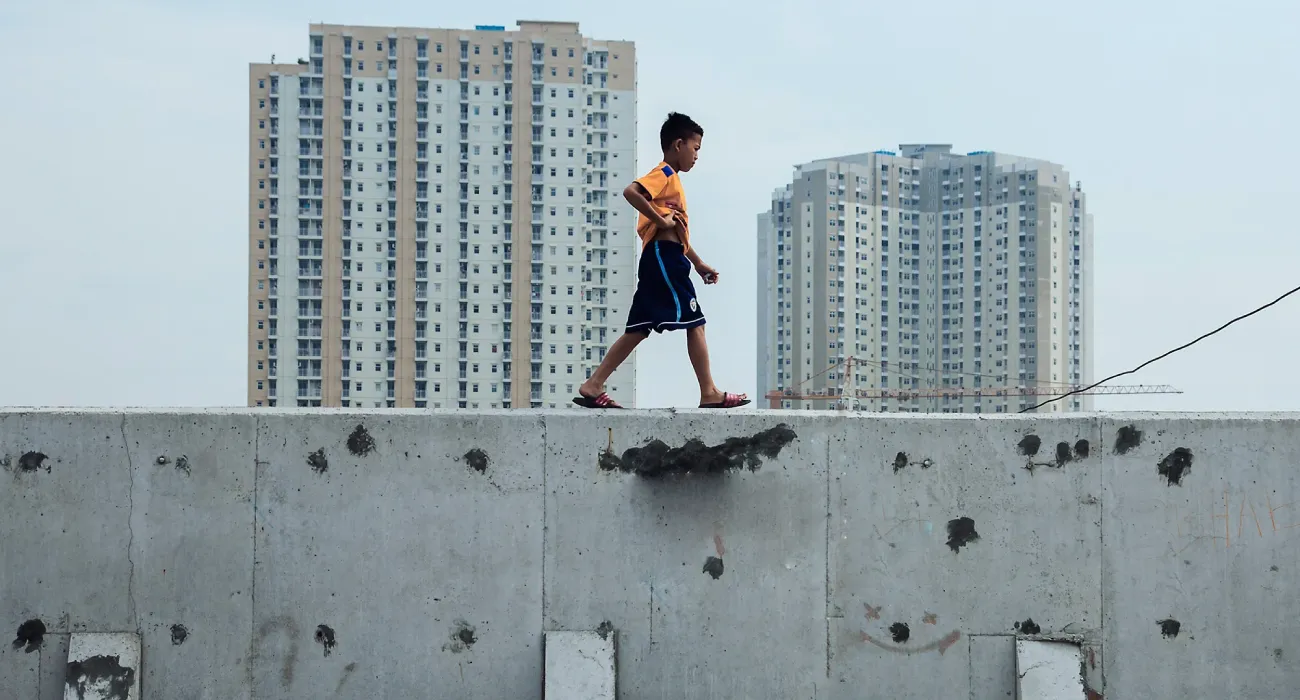Jakarta’s administration has pledged its support for President Prabowo Subianto’s ambitious seawall megaproject, a sprawling initiative aimed at curbing the city’s chronic flooding and land subsidence. Despite the promise of protection, the plan has ignited fierce debate over its environmental impact, financial burden, and apparent conflict with local conservation goals. Governor Pramono Anung’s commitment to allocate Rp 5 trillion (US$307 million) annually to the project has drawn sharp criticism from environmentalists who argue it undermines efforts to restore Jakarta Bay’s mangrove ecosystems.
A Megaproject to Shield Jakarta
Last week, President Prabowo urged Jakarta’s administration to contribute to the seawall project, a 19-kilometer structure along the city’s northern coast that forms part of a broader 500-kilometer barrier stretching from Banten to East Java. Estimated to cost up to US$80 billion over 20 years, the initiative is touted as a critical defense against coastal flooding, with northern Jakarta sinking by as much as 15 centimeters annually due to land subsidence. The President has projected an annual budget of US$1 billion for the Jakarta Bay segment alone, with completion targeted within eight years.
At the Jakarta Future Festival on Sunday, Governor Pramono confirmed the city’s readiness to play its part. “This is a long-term project, Jakarta will prepare for it” he stated, outlining plans to dedicate a significant portion of the city’s record-high Rp 91.34 trillion budget for 2025 to the effort. This marks a substantial increase from previous years, with budgets of Rp 85.1 trillion in 2024 and Rp 83.7 trillion in 2023, according to state news agency Antara.
The seawall gained formal recognition as a national strategic project on February 10 through Presidential Regulation No. 12/2025, part of the 2025-2029 National Medium-Term Development Plan. This designation streamlines land acquisition and permitting processes, signaling the government’s determination to push forward despite mounting opposition.
Environmentalists Sound the Alarm
Environmental groups have condemned the seawall as a risky endeavor that prioritizes infrastructure over ecological sustainability. Jeanny Sirait, an urban campaigner with Greenpeace Indonesia, criticized the project for its potential to harm Jakarta Bay’s delicate marine environment. Speaking to The Jakarta Post on Monday, she argued that the government should focus on restoring mangroves, which act as natural barriers against flooding. “The government can build temporary, small-scale embankments while simultaneously restoring the mangroves” she urged, warning that a permanent seawall could have devastating effects on both the ecosystem and local communities.
Such concerns are compounded by Governor Pramono’s earlier campaign pledge to develop a massive mangrove ecosystem in Jakarta Bay—a promise that appears at odds with the current seawall commitment. Mangroves, which have been the focus of community rehabilitation efforts in areas like Teluk Naga on Jakarta’s outskirts, are seen as a cost-effective and environmentally friendly solution to coastal erosion. Critics fear that the seawall could disrupt these initiatives, potentially exacerbating rather than mitigating environmental degradation.
Elisa Sutanudjaja, executive director of the Rujak Center for Urban Studies, offered a nuanced perspective, acknowledging that embankments attached to land could help in severely eroded areas. However, she questioned the logic of constructing barriers in the middle of the sea without addressing the root cause of subsidence. “Building embankments in the middle of the sea, especially if the underlying issue of land subsidence is not adequately addressed, raises questions about the project’s urgency and effectiveness” she noted.
Public Sentiment and Community Impact
Beyond environmental concerns, the seawall project has sparked unease among coastal communities who fear displacement and loss of livelihoods. A survey conducted by the fisheries watchdog Destructive Fishing Watch (DFW) in April revealed that 56 percent of 105 respondents in the Greater Jakarta area disapproved of the project. Many cited worries over environmental damage and the potential disruption to fishing and other local industries that depend on access to the bay.
Jakarta’s northern coast is home to densely populated, low-income neighborhoods that are particularly vulnerable to both flooding and the socioeconomic fallout of large-scale infrastructure projects. While the seawall aims to protect these areas from rising sea levels, there are lingering doubts about whether the benefits will reach those most in need—or if the costs, both financial and social, will outweigh the gains. If local voices are sidelined, the project risks fueling resentment among communities already grappling with the effects of urban inequality.
A History of Debate
The concept of a seawall to shield Jakarta from flooding is not new. Discussions date back to at least 1994, reflecting decades of concern over the city’s vulnerability to rising sea levels and subsidence driven by over-extraction of groundwater. Yet, successive administrations have struggled to balance the need for flood defenses with environmental and budgetary constraints. The current iteration of the project, now elevated to a national priority under President Prabowo, represents the most concrete step yet toward realization—but also the most contentious.
Critics argue that the government’s focus on a colossal infrastructure solution overlooks simpler, more sustainable alternatives. Mangrove restoration, improved urban planning, and stricter regulation of groundwater extraction could address many of the same issues at a fraction of the cost. The seawall’s projected US$80 billion price tag, even spread over two decades, places immense pressure on public finances, particularly for a city like Jakarta where competing priorities—education, healthcare, and transport—also demand significant investment.
Financial Strain and Political Will
Governor Pramono’s pledge to allocate Rp 5 trillion (US$307 million) annually raises questions about Jakarta’s fiscal capacity to sustain such contributions over the long term. While the city’s 2025 budget is the highest in its history, critics warn that diverting such a substantial sum to the seawall could strain resources for other essential services. The project’s broader cost, estimated at US$1 billion per year for the Jakarta segment alone, suggests that even with the city’s contribution, additional funding—potentially from central government coffers or international loans—will be necessary.
President Prabowo’s administration has framed the seawall as a cornerstone of its infrastructure agenda, reflecting a broader push for transformative projects to bolster Indonesia’s resilience against climate change. Yet, the scale of the financial commitment, coupled with environmental opposition, places the project at a crossroads. If costs spiral or public discontent grows, the seawall could become a political liability for both the President and Governor Pramono.
Looking Ahead: Balancing Progress and Preservation
As Jakarta braces for the seawall’s construction, the tension between development and conservation remains unresolved. Environmentalists continue to advocate for mangrove restoration and smaller-scale flood defenses, while community leaders call for greater consultation with affected residents. The project’s designation as a national strategic priority may expedite its rollout, but it also heightens the stakes for ensuring transparency and accountability in its execution.
For now, the seawall stands as both a symbol of ambition and a source of division. Whether it will protect Jakarta’s future or imperil its natural and social fabric remains an open question—one that will likely shape the city’s trajectory for decades to come.
















